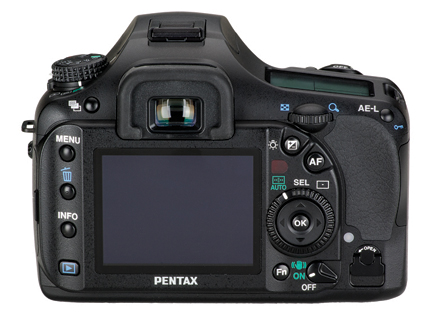The Pentax K20D; At 14.6Mp, The Flagship Of The Pentax D-SLR Line-Up
The 10-megapixel Pentax K10D was a very popular camera thanks to its rugged, splashproof construction, built-in Image Stabilizer, some unique features, and excellent image quality.
 |
 |
The new K20D is even more desirable. Featuring the highest resolution in its class, this 14.6-megapixel D-SLR is now the flagship of the Pentax line. Although it retains the best features and technology of its predecessor, the new model is significantly different in some respects. Let's take a quick look at those changes as an introduction to the K20D. In a subsequent issue, we'll provide a Test Report and images made with a production-level camera.
Primary Benefits
This First Look report was written before the K20D was announced, using preliminary
specifications and an early preproduction sample. Hence, it is possible that
one or two bits of technical information may have changed slightly by the time
you read this. In any event, I considered the following new features to be the
most valuable.
· The camera employs a CMOS (not CCD) sensor with an Analog to Digital
converter. (Apparently this sensor was co-developed with Samsung.) According
to a Pentax rep, "any gain increase for higher sensitivity [ISO] is done
on the sensor itself, rather than in the A/D converter, resulting in an image
with less digital noise."
· Live View is now available, for a real-time preview of a scene on the
slightly larger, fixed (not articulated) 2.7" LCD monitor with a wider
160° viewing angle. Manual focus--with preview magnification if desired--is
recommended in Live View but autofocus, with conventional phase-detection technology,
is also available.
· The sensor and the PRIME processor (with 22-bit A/D conversion) should
provide clean images but a new menu item allows the user to activate High ISO
Noise Reduction (NR) at any of three intensity levels. (Long exposure NR also
remains available on demand.)
· In addition to nearly 50 percent higher resolution, the K20D provides
an extra JPEG Quality option--Premium, with minimal compression--for the best possible results.
· Although the camera generates much larger 12-bit PEF or DNG format raw
files, or 8-bit JPEGs, the continuous drive speed has been maintained at a fast
3 fps. Note, too, that fast processing plus a large buffer (with DDR2 RAM) make
it possible to shoot a series of 38 JPEGs at this speed when using a Class 6
SDHC card.
· The new Burst Shooting mode allows for blasting off a long series of
JPEGs at a lightning-fast 21 fps, though only at 1.6-megapixel resolution.
· The camera offers a new series of Picture Style modes (called Custom
Image): Natural, Bright, Portrait, Landscape, and Vibrant. Each mode provides
an entirely different "look" but can also be customized as desired
in terms of sharpness, contrast, color saturation, and hue levels. A BW (Monochrome)
mode is also available with options for filter effects, toning, contrast, and
sharpness.
· In addition to the familiar sensor cleaner, a new Dust Alert feature
provides a "snapshot" of the CMOS sensor, indicating the exact size
and location of any dust specks.
· A Dynamic Range Adjustment option can be set in Capture mode and a High
Dynamic Range processing feature has been added to Playback mode. Both modify
exposure and contrast for greater highlight and shadow detail; that should be
useful in very contrasty lighting.
· The K10D provided many post-processing features for image enhancement,
but the K20D provides a few more options. That includes a utility for in camera
conversion of raw photos to TIFF and not merely to JPEG format.
· A PC cord socket for connecting the camera to a studio flash ("strobe")
system has been added.
 |
Conclusion
Aside from the ultrahigh-resolution sensor, the Live View feature should keep
Pentax competitive in the advanced or "prosumer" D-SLR category.
Do note, however, that Live View is slightly different than it is with other
D-SLRs. When AF is selected, focusing does not begin until after the shutter
release button is fully depressed. Consequently, instead of a delay for focus
acquisition while composing an image, "shutter lag" occurs just
before the photo is actually taken. Frankly, as with any D-SLR that provides
Live View, manual focus is preferable whenever it's important to capture
just the right instant.
Targeting the experienced D-SLR user, the K20D is very versatile but convenient
to use, thanks to a full range of logical analog controls and a Function submenu
for quick access to frequently used features. Because the light metering, autofocus,
Shake Reduction (stabilizer), and White Balance systems have been transferred
from the K10D, the K20D should be similar in basic performance. Although the
preproduction sample was functional in most respects, I won't provide
any actual evaluations until the full Test Report.
It's worth repeating a comment from my K10D review, however. For lightning-fast
autofocus in sports photography, use one of the Pentax DA* lenses with the very
fast and nearly silent Super Sonic Wave Motor. Of course, the new camera retains
compatibility (with a few limitations) with older manual focus K-mount lenses,
even providing the Anti-Shake stabilization feature. Buy an optional adapter
and you can also use screwmount and 645 system lenses.
Except for the entirely new CMOS sensor, the K20D should be viewed as an evolutionary
development and not as a revolutionary new camera. Even so, it should definitely
appeal to any serious photographer who does not need an ultra-fast framing rate
in high-resolution capture. When compared to other D-SLRs in its price range,
the Pentax K20D should be a strong contender because of its 14.6-megapixel sensor,
splashproof body, and wide range of advanced capabilities. In my estimation,
this will be a very successful camera.
For more information, contact Pentax Imaging Company, 600 12th St., Ste. 300,
Golden, CO 80401; (800) 877-0155; www.pentaximaging.com.
































